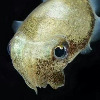HOME | DD
 TrollMans — The Five Rapacious Vassals
TrollMans — The Five Rapacious Vassals

Published: 2021-10-18 18:25:26 +0000 UTC; Views: 54730; Favourites: 562; Downloads: 57
Redirect to original
Description
When the first explorers set foot beyond the wall of blackened rock along the coast, one of the most horrific sights which confronted them were the insectoid beasts of immense scale, far more massive than any terrestrial invertebrates on any continent, easily large and ferocious enough to prey on the unknowing humans which had dared venture past the comforting veil of industrial civilization, and into a world far older and more visceral. A number of men met fates agonizing beyond description as they attempted to catalogue the hidden world of R'lyeh over the decades, to know that which had almost purposefully been hidden from the eyes of mankind. Their sacrifices were not in vain however, as collective specimens and research into the biological secrets of the pararthropods have diluted their nightmarish mysticism since their initial encounters.Pararthropods comprise both one of the primary faunal and floral groups endemic to the corpse-isle; through their dual exoskeletal and endoskeletal support and an analogously vertebrate-like cardiorespiratory system, they have been able to reach immense sizes. Many species have evolved to derive most of their energy from photosynthesis as mixotrophic or autotrophic producers, while others have radiated into an incredibly diverse variety of morphological and ecological forms as heterotrophs, from flesh-squirming vermiform parasites, soil-scuttling detritivores, secondarily aquatic serpents of the dark murk, to the forms most well documented, the terrestrial hunters, with spindly clawed arms and sheering mandibles. While only a relatively small number of species are known to actively hunt humans, their outward appearances alone denote them as one of the most feared of R'lyeh's inhabitants.
---
STINGBEAST: A clambering all-terrain predator of the interior jungle, these innovative and disturbingly ape-like beasts are as curious as they are bloodthirsty. Sexes are nearly physically identical, both reaching around twenty-kilograms in mass, but with a lanky appearance making them seem larger than this would imply. Males are largely solitary or live in small sibling groups, while females tend to associate in larger congregations; this is because the act of mating is quite violent. Males will attempt to capture a female alone and using a blade-like intromittent organ to forcibly penetrate her; if the other females catch sight of this, they will tear the male limb from limb, so there is incentive for males to be fast enough, sneaky enough, and strong enough to catch a lone female, mate with her, and escape before her sorority becomes aware. Like many pararthropod species, stingbeasts are parasitic organisms, and females have a similarly pointed ovipositor to inject their larvae into a host animal (usually a xenotherian). Larger hosts may survive when the mature larvae emerges, although the complications of the growing parasite inside them ultimately kills most. If a larvae is forced to emerge early, they undergo metamorphosis into a unique life-stage known as a myling. Mylings are hermaphrodites which have a very short lifespan, and attempt to capture and forcibly impregnate host animals much more aggressively than the primary morph.
CITY MEGASPIDER: The largest of the hunting megaspiders, at up to twenty-eight kilograms in weight, with a leg-span of nearly six feet across, this also has one of the most complex social structures of the several species. The species is, by all accounts, a living nightmare, enormous spider-like pack hunters with intelligence unexpected in a creature of such appearance. As their name suggests, the city megaspider creates large hive-like nests by binding together the hollowed out shells of large planimals with hardened mucous secretions, structures which may be well over twelve metres in diameter and hold one to two dozen adult individuals. This is taken to extreme by the "Leng Supercolony", residing within the Leng Plateau complex, which spans multiple nests containing over two hundred individuals and constructed several millennia by numerous generations. Despite appearances, they are nonvenomous and usually take much smaller prey and planimal eggs as generalist foragers, but they are certainly very territorial and more than willing to attack larger animals, particularly in defence of their nests. Like other megaspiders, they feed their young on a special protein-rich "milk" which is secreted from the underside of their abdomen.
SLITHERY-DEE: The most immense of R'lyeh's numerous endemic predators, this is the undisputed ruler of the island's extensive waterways, and capable of reaching up to eight metres in length and nearly two tonnes in extreme cases, although ironically it, along with all other vermidragons, are descended from a lineage of animal-derived flora which returned to a motile existence. This primordial-looking aquatic predator cruises through the murky depths by undulations upon the rows of flesh along its flanks, the dorsal rows of flora-encrusted ragged, chitinous plates acting as camouflage when it surfaces, its bulky armoured head pushing aside any vegetative obstacles in its path, small caravans of commensals and symbionts trailing by their side (such as the ever-present cometfish). The slithery-dee is an efficient hunter, simply engulfing smaller prey with an elastic maw that literally sucks prey in, multiple rows of backwards facing teeth ensuring a secure capture, which may be entire shoals of fish-like swimmers or an unfortunate urchin-hog (or just as unfortunate human explorer) coming down to drink. Although almost exclusively aquatic, they are still capable of air-breathing and retain hooked appendages that can drag them across land for short distances (useful for navigating the heavily clogged rivers and lakes of R'lyeh).
PORONEK: A much smaller close relative of the stingbeast, at only five or six kilograms in weight. Despite this, it is certainly among the most gruesome predators of the jungle; the subtle chirping and whimpering calls of the fast-moving naghouls communicating amongst one another in the distance will stir primal fear in any forest dweller. Utilizing stolen nematocysts from cnidarian planimals, larger prey animals can be incapacitated by their neurotoxic bite and fed upon alive, but an unlucky few face an even worse fate: becoming the first warm meal for the poroneks' developing larvae. The unfortunate host is enveloped with silk-like secretions alongside the developing egg sacs after the adults clean the quarry of hair, scales, claws, or clothing in preparation; although the cleaning process is quite painful, the poroneks take great lengths to ensure the host remains alive until the larvae hatch. Luckier victims will be dead a few hours after the larvae begin feeding, but in some cases it may take more than a day for the animal to die as the larvae burrow into its flesh and consume it from the inside out, avoiding the major organs to keep the meat from rotting for as long as possible. Normally nomadic, they settle down for a few weeks to breed, creating temporary nests that they vacate after the young eat through their incapacitated victim, and then carrying the plumped up nymphs on their bodies as they clamber through the trees in search of further prey to satiate them. And so it is the paradox a creature of clear and deep parental devotion is capable of inflicting such unspeakable torment upon its prey.
TREESNATCHER: While there are dozens of species of truly photosynthetic pararthropods, this is a rarer species which mimics its (usually) more harmless relatives as a specialized ambush hunter vaguely resembling a gigantic stick-insect. Up to nine feet tall when standing erect, its extremely slender body and spindly, spiny appendages (often supplemented with collected debris and symbiotic creeping flora) allow it to blend in perfectly in the R'lyehian flesh jungle, standing still for days or even weeks, lulling in unwary prey within reach of its highly extendable feeding arms where they can be quickly restrained and brought to the killing mandibles. Hunting prey the size of humans is uncharacteristic, but it's not uncommon for particularly hungry or overenthusiastic treesnatchers to react instinctively to movement, even of animals that would would be difficult to kill. Despite their size and menacing appearance, these are fairly skittish predators, giving up quickly if unable to incapacitate their prey within a couple seconds and giving up their kills without much resistance if confronted by another predator. The treesnatcher is a paper tiger, as most of its body is riddled with an extensive system of air sacs, allowing them to stand erect without strain, but making them very ill-equipped for physical combat.
Related content
Comments: 31

👍: 0 ⏩: 0

👍: 1 ⏩: 0

👍: 0 ⏩: 0

👍: 0 ⏩: 0

👍: 0 ⏩: 0

👍: 1 ⏩: 1

👍: 0 ⏩: 1

👍: 1 ⏩: 0

👍: 1 ⏩: 0

👍: 0 ⏩: 1

👍: 0 ⏩: 1

👍: 1 ⏩: 0

👍: 0 ⏩: 0

👍: 0 ⏩: 1

👍: 1 ⏩: 0

👍: 0 ⏩: 0

👍: 0 ⏩: 0

👍: 0 ⏩: 1

👍: 0 ⏩: 0

👍: 0 ⏩: 0

👍: 0 ⏩: 1

👍: 2 ⏩: 0

👍: 0 ⏩: 0

👍: 0 ⏩: 1

👍: 1 ⏩: 0

👍: 2 ⏩: 1

👍: 0 ⏩: 1

👍: 0 ⏩: 0

👍: 2 ⏩: 0

👍: 1 ⏩: 0

















